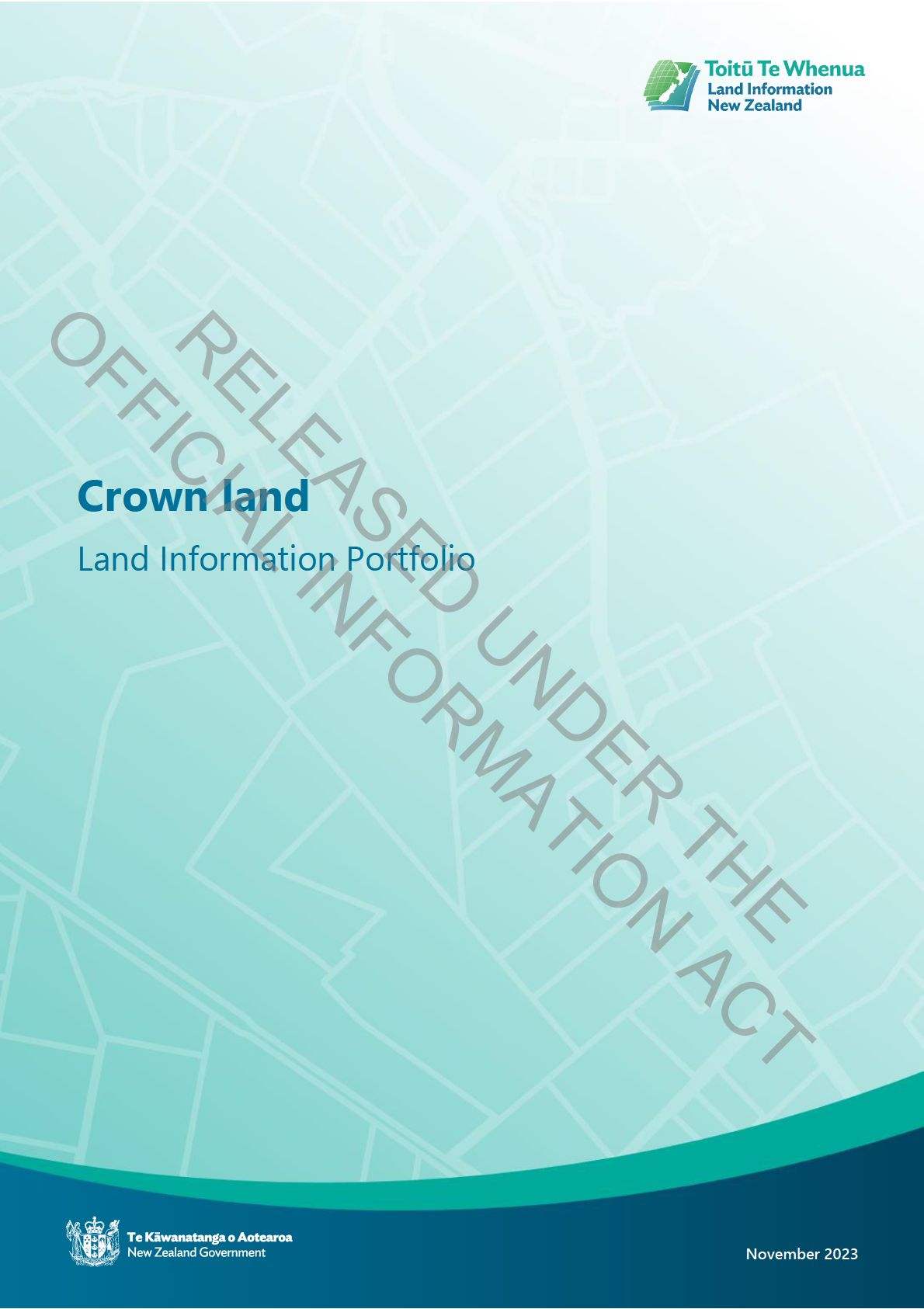
Crown land
Contents
1
Introduction ............................................................................................................................ 3
2
Your role as Minister for Land Information ......................................................................... 5
2.1 You maintain the legislative framework for Crown land ........................................................................... 5
RELEASED UNDER THE
OFFICIAL
2.2 You have esponsibility for Crown land LINZ manages .............................................................................. 6
2.3 You h ve decision-making responsibilities on compulsory land acquisition under the Public
Works Act 1981 ......................................................................................................................................................... 7
2.4 Directing LINZ on any areas of policy development.................................................................................... 8
3
Crown land ........... .......... .. ................................................................................................. 10
3.1 The Crown land regime ...... ...... ... .................................................................................................................. 10
3.2 LINZ holds and manages land on behalf of the Crown .......................................................................... 10
3.3 LINZ has responsibility for biosecurity and biodiversity on Crown land it manages ................... 19
INFORMATION
4
Public Works Act .. ..... ... .................. ......... ....................................................................... 21
4.1 Acquisitions of land ........... . ...... ... ........................... .................................................................................... 21
4.2 Land that is no longer needed for public works ...... ..... ..................................................................... 23
4.3 Improvements to PWA processes ............ ..................... ....... .... ................................................................ 24
5
Strategic outlook for Crown land..... ......
................. .......... ......................................... 25
6
Next steps ............................................................. . ............... ...... ...... ............................ 26
Annex 1 Critical relationships ...................................... ... ... ......................... ............................. 27
Annex 2 Functions and responsibilities under the PWA ........ ......... ..................... ................. 29
ACT
2
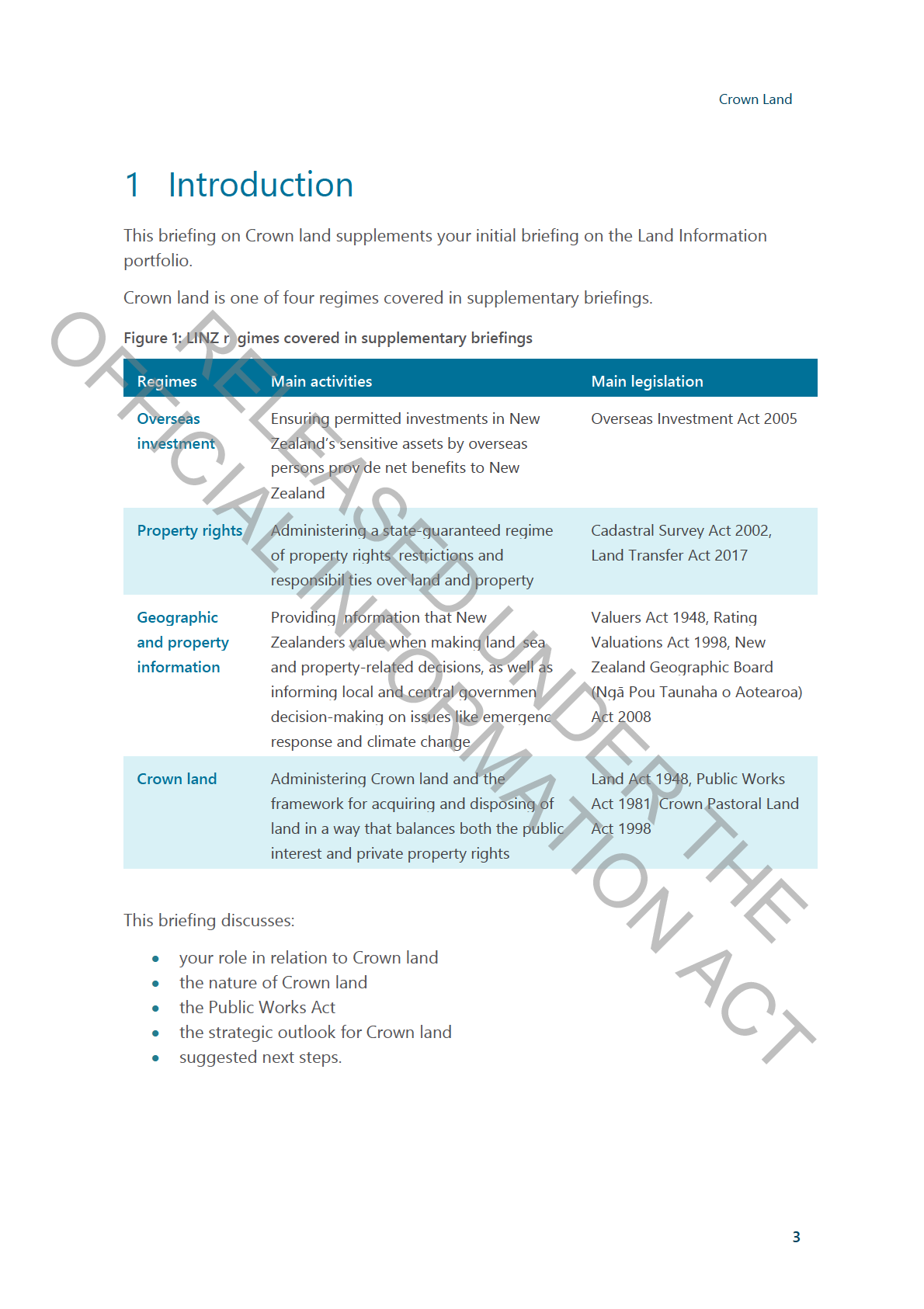
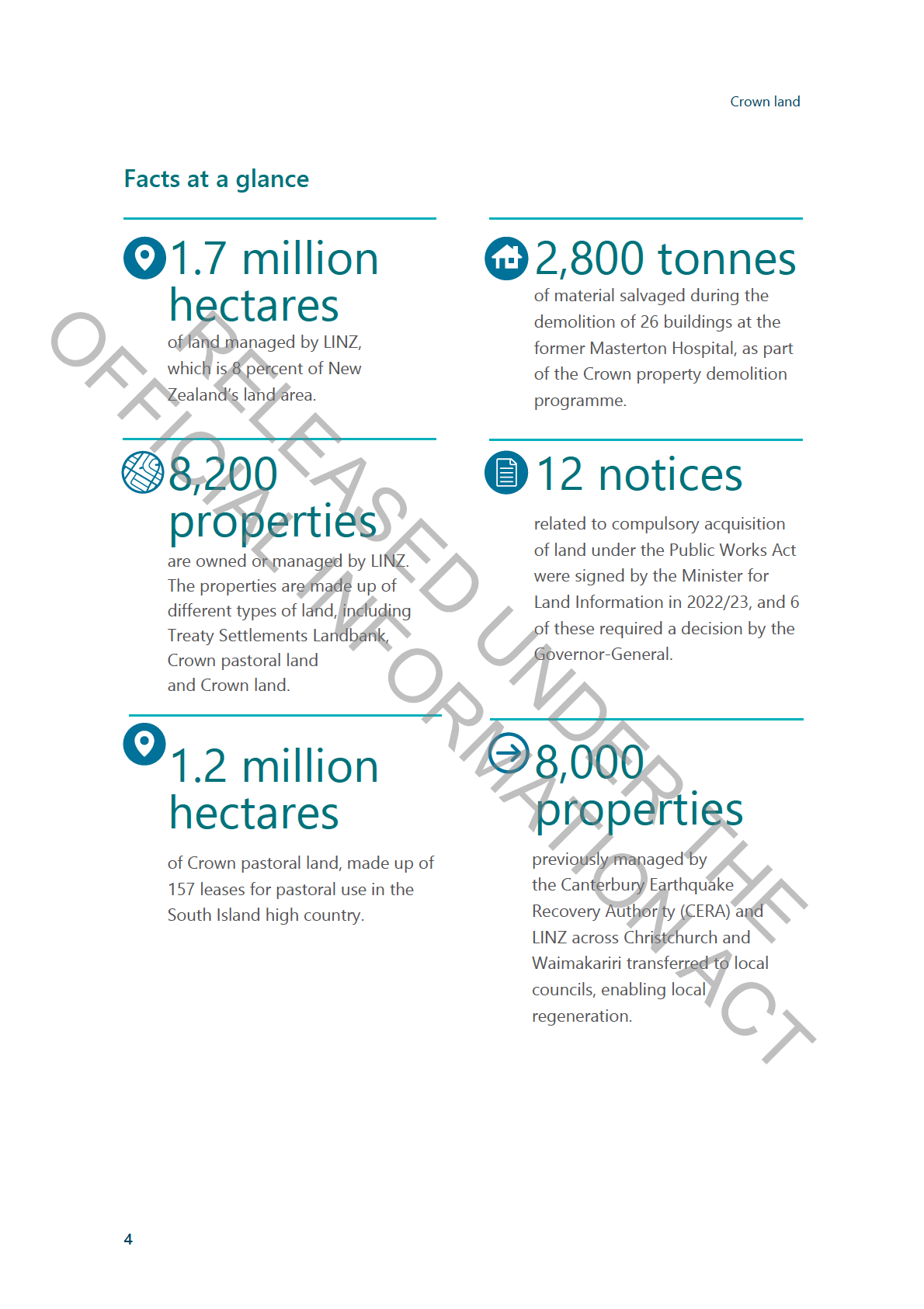
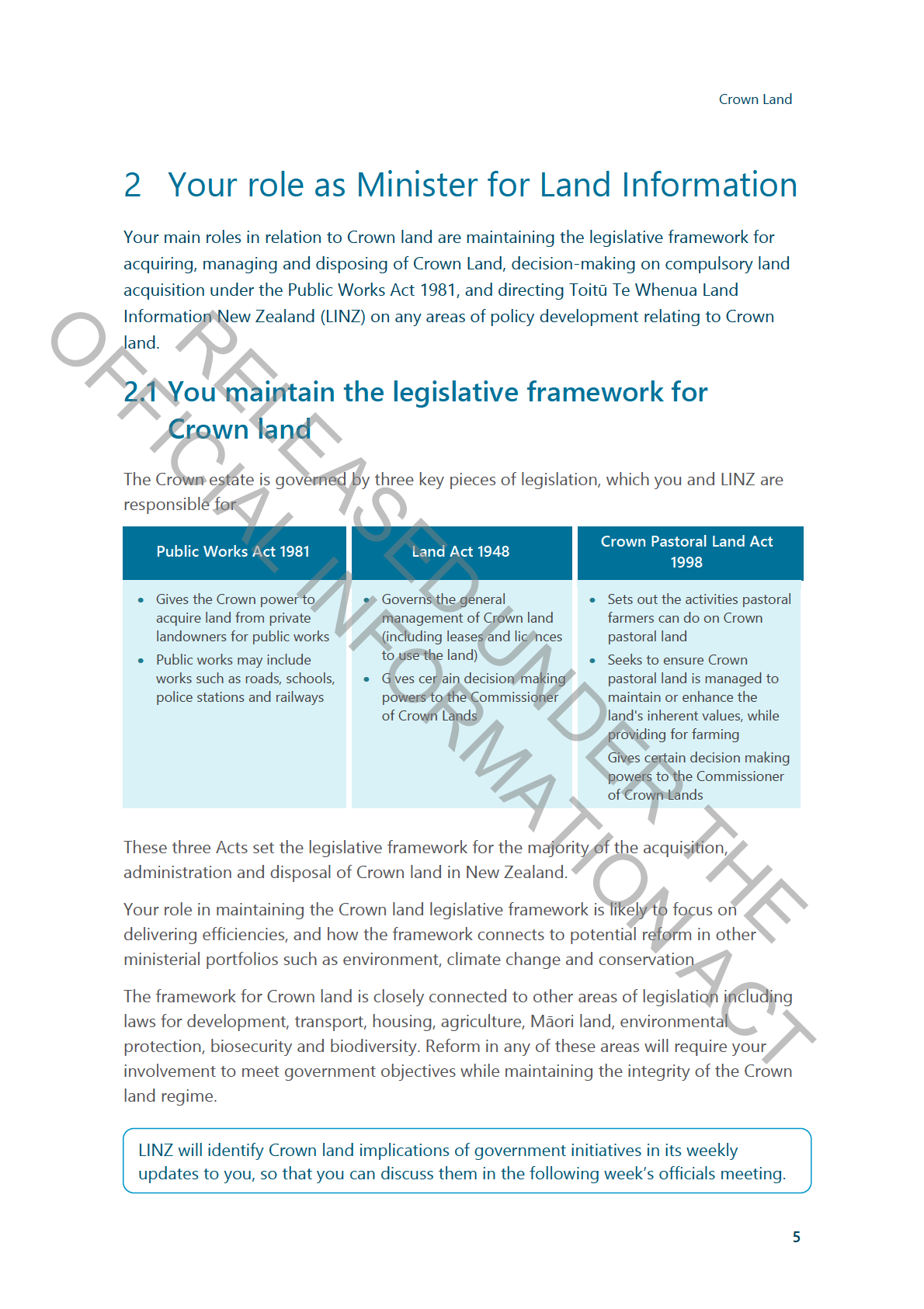
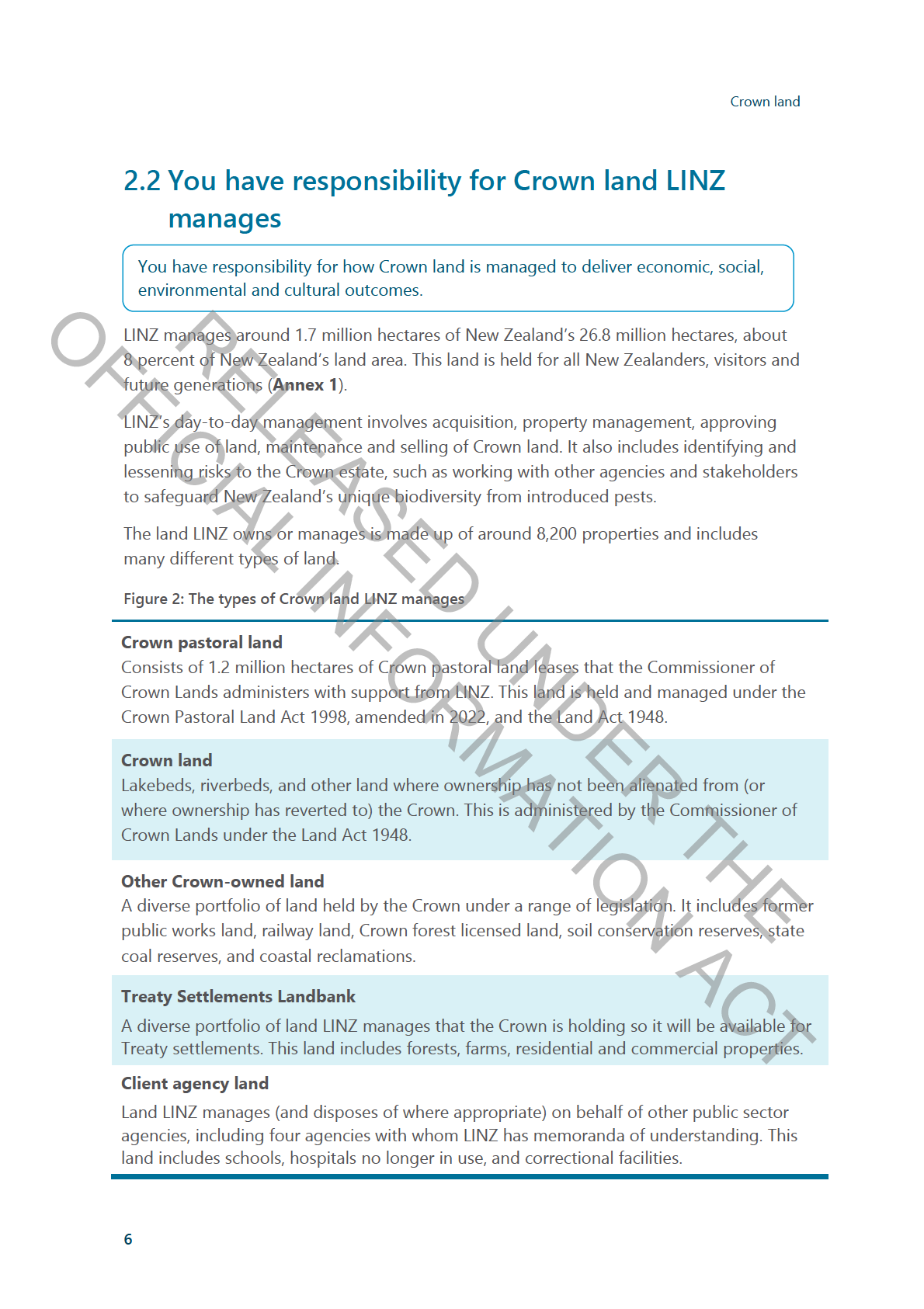
Crown Land
2.3 You have decision-making responsibilities on
compulsory land acquisition under the Public
Works Act 1981
You and LINZ’s chief executive exercise powers under the Public Works Act 1981 (PWA).
RELE
OFFIC
These powers generally fall into the two categories of acquisition and disposal:
• as Mini ter, you are responsible for acquiring land for government works
undertaken by Crown agencies
• decisions elating to disposal of land reside with the LINZ chief executive and LINZ
staff under delegation from the chief executive
• local authorities may acquire and dispose of land for local works without involving
you except in instance where powers of compulsory acquisition (taking land by
AL S
proclamation) are used In these cases, your role under the Act is to request the
proclamation from the Governor-General, on behalf of the local authority.
D UNDER THE
INFORMATION
Given the large number of PWA acquisitions and transfers that are required on a regular
basis, previous ministers have chosen to delegate most decisions to LINZ (for the 2022/23
period, 53 acquisitions were made by LINZ and 12 transfer agreements to change the
public work purpose for which land is used were made)
Annex 2 provides a summary of
functions and responsibilities under the PWA for the Governor-General, you as Minister
for Land Information, and LINZ.
The PWA allows government to deliver critical inf astructure that New Zealanders rely on
such as highways, housing and railways, enabling economic growth and development.
The PWA gives the Crown power to acquire land from private landowners for government
and local public works. Public works may include roads schools, justice precincts and
hospitals.
Given the role of the PWA in the provision of land for the development of infrastructure,
LINZ will work with you and other agencies on proposals to improve the delivery of
infrastructure.
ACT
Waka Kōtahi New Zealand Transport Authority (NZTA) plays a large role in public
works, supported by LINZ. Acquisitions under the PWA allow for road safety
improvements and the enhancement of highway connectivity across New Zealand.
Further, the PWA plays a key role in the Crown response to emergencies such as
Cyclone Gabrielle. Significant transport recovery works were needed to be completed
by NZTA and KiwiRail, which used the PWA to acquire land to support the recovery.
The PWA aims to balance the rights of private landowners with the Crown’s ability to
ensure public works go ahead.
7
Crown land
The PWA aims to treat landowners fairly when their land is acquired by the Crown. This
includes that landowners are fairly paid for their land, it encourages acquisition by mutual
agreement with landowners, and when land is no longer required landowners are given
the opportunity to buy the land back.
Acquisition of land under the PWA can attract public attention, and decisions are
sometimes challenged or disputed by landowners who are affected. Compensation can be
RELE
OFFIC
resolved at the Land Valuation Tribunal after land has been taken. LINZ manages media
queries and LINZ will update you as needed on matters of interest or concern that arise
from acquisition.
When land is no longer required there is a disposal process set out in legislation. This
process directs how land is transferred from one public work to another, and the various
steps that must be undertaken including potentially offering land back to former owners
AL
or their successors This disposal process also includes ensuring that Treaty obligations
S
are met, which could include offering the land to iwi under a first right of refusal, or
determining if it i appropriate to include it in a Treaty settlement.
D UNDER THE
INFORMATION
You may also occasionally be asked (along with other Ministers, including Finance and
Housing) to approve transfers of Crown-owned land to Kainga Ora for urban
development projects under the Urban Development Act 2020. To date, one property has
transferred under this Act, however, Kainga Ora has adv sed that it has other Crown-
owned properties that it is seeking to acquire for housing projects.
To give you a sense of scale of this work, in 2022/23, 12 notices related to
compulsory acquisition were signed by the Minister for Land Information, with 6 of
these requiring a decision by the Governor-General.
2.4 Directing LINZ on any areas of policy
development
You may have already identified areas of potential policy development n relation to
Crown land, or you may identify these as you administer this portfolio. ACT
LINZ can provide advice on policy you are interested in delivering in relation to
Crown land.
8
Crown Land
2.4.1 Reserves and Other Lands Disposal Consolidation Bill
Since 1864, many private and individual Reserves and Other Lands Disposal (ROLD) Acts,
and related Acts have been passed to resolve non-controversial administrative issues with
public and private land that cannot be dealt with through other processes.
LINZ is working with the Parliamentary Counsel Office to draft a Reserves and Other
RELE
OFFIC
Lands Disposal Consolidation Bill (the ROLD Bill).
This will consol date several ROLD and related Acts by repealing 21 Acts and capturing
any provisions that are still required in a consolidated ROLD Act. It will also create a
process to allow for amending this Act going forward, rather than adding new ROLD Acts,
creating a more efficient regulatory regime. In early 2024, LINZ will seek your decision on
whether you would like to proceed with introducing the ROLD Bill in 2024.
AL S
D UNDER THE
INFORMATION
ACT
9

Crown land
3 Crown land
3.1 The Crown land regime
LINZ administers the legislation underpinning the Crown land regime that you are
responsible for.
RELE
OFFIC
The Comm ssioner of Crown Lands (the Commissioner) is a statutory officer with specific
functions and decision-making powers under the Crown Pastoral Land Act 1998, and the
Land Act 1948. The Commissioner is an independent regulator, an employee of LINZ and
accountable to the chief executive.
Figure 3: The Commissioner of Crown Lands
AL S
• Acts as a landowner for the Crown
• Makes decisions on discretionary activities, easements, and
commercial recreation permits on Crown land
D UNDER THE
Undertakes monitoring and compliance activities
INFORMATION
(including inspections)
• Manages lease transfers, renewals and rent reviews. Acts as
Craig Harris, Commissioner of Crown Lands
the landlord for Crown pastoral leases and other lessees.
3.2 LINZ holds and manages land on behalf
of the Crown
The Crown land LINZ holds is acquired, managed and disposed of under a range of
legislation such as the PWA and Land Act 1948, or other legislation where LINZ has a
statutory role. This includes the Marine and Coastal Area (Takutai Moana) Act, and
railways or mining legislation. LINZ manages this ‘Crown estate’ to deliver the greatest
benefits to all New Zealanders, both for today and in future.
LINZ does a wide range of work on the Crown land it manages, including:
• acquiring, maintaining and disposing of land
ACT
• managing the tenancies of farmers who lease grazing land
• managing the tenancies of leaseholders occupying Crown property
• maintaining built structures
• identifying and managing risks (for example, protecting the plants and animals on
Crown land)
• providing property management services to other Crown agencies
• releasing assets to iwi for Māori and regional development.
10

Crown Land
Not all Crown land is managed by LINZ. Multiple government agencies such as the
Department of Conservation (DOC), NZTA, the New Zealand Defence Force and the
Ministry of Education administer different types of Crown land under different legislation.
3.2.1 Crown pastoral land
As Minister for Land Information, you have responsibility for the Crown pastoral land
OFFIC
legislative framework, which is guided by:
RELE
Figure 4: Map of Crown pastoral land
• Crown Pastoral Land Act 1998 (CPLA)
• Land Act 1948.
LINZ manages the Crown pastoral estate, which
stretches from Marlborough to Southland. This land
encompasses some of New Zealand’s most iconic
landscapes Activit es on Crown pastoral land make an
AL S
important contribution to regional economies and
communities.
D UNDER THE
INFORMATION
In administering this land LINZ works closely with
leaseholders who farm and live on the land and have a
strong connection to it.
The land also has particular significance for Māori – in
particular Ngāi Tahu, and Te Tauihu iwi: Rangitāne o
Wairau and Ngāti Apa ki te Rā Tō Te Tauihu
1
Leaseholders need permission from the Commissioner to carry out activities on their
lease. Pastoral leaseholders are responsible for managing the land, including weed and
pest control.
LINZ has previously engaged with leaseholders and stakeholders on the characteristics
and challenges of pastoral leases when considering policies to manage on-farm
emissions.
3.2.1.1 The Commissioner of Crown Lands
ACT
The Commissioner of Crown Lands (the Commissioner) makes decisions on discretionary
activities, easements, and commercial recreation permits and is responsible for certain
decisions and functions under the CPLA and the Land Act. The Resource Management Act
also applies to Crown pastoral land, and consent from the Commissioner does not affect
the need for leaseholders to comply with relevant regional and district plan requirements.
1 Te Tauihu is a body of eight tribes in the Nelson-Marlborough region of the upper South Island. Te Tauihu is comprised of
Ngāti Kuia, Rangitāne, Ngāti Apa, Ngāti Koata, Ngāti Rārua and Ngāti Toa, Ngāti Tama and Te Āti Awa.
11

Crown Land
LINZ will report to you quarterly on application processing and planning.
3.2.1.4 Mackenzie Basin Agency Alignment Programme: Te Mokihi
The Mackenzie Basin is high value landscape. Crown pastoral leases and other Crown land
is contained in the area.
LINZ, DOC, Environment Canterbury, and the Mackenzie and Waitaki District Councils
RELE
OFFIC
form the Mackenzie Basin Agency Alignment Programme: Te Mokihi (the programme).
Since 2018 the programme has worked to align information and advice to decision-
makers on land and water use and to support better outcomes for communities and the
environment.
The upcoming Te Mokihi Chief Executives Forum is scheduled for February/March 2024.
3.2.2 Crown land held by LINZ is administered by the
AL S
Commissioner
Crown land makes up a large amount of the land LINZ manages, and it is administered by
D UNDER THE
INFORMATION
the Commissioner unde the Land Act. This land is made up of a range of land parcels in
varying sizes, and sites such as hydropower lakebeds and riverbeds2 on the bed of the
Waikato River and several lakes in the Mackenzie. In general, Crown land is not held in
any form of title.
Crown land can be disposed of through the Land Act, e ther by sale (known as
‘alienation’) or by granting a lease or licence for use of the land. A y alienation must
comply with the Land Act and any relevant Treaty settlement legislation.
Under many Treaty settlements, the Commissioner has entered into relationship
instruments with iwi relating to how LINZ manages riverbeds and other areas of Crown
land. As Minister for Land Information, you are also party to several accords entered into
with iwi relating to the Waikato and Waipā Rivers. This includes attending an annual
relationship meeting with each iwi.
3.2.2.1 Fresh and seawater areas
ACT
As Minister for Land Information you have a role in acquiring fresh and seawater areas.
If an overseas investor is seeking to purchase sensitive land in New Zealand w th consent
under the Overseas Investment Act 2005 they must offer the Crown an opportunity to
acquire any fresh or seawater areas (FSAs) that are contained within that property, such as
riverbeds or coastal strips. The Crown may waive this right, though this is rare. You are
responsible for approving or waiving the right to acquire this land on behalf of the Crown.
2 LINZ’s role is to manage the bed of the lake or river, not the water.
13
Crown land
LINZ is responsible for the acquisition process. Depending on the type of land area
acquired as an FSA, LINZ may put a title on the acquired land, survey the area, or remove
a portion of the land from the investor’s title. Landowners are compensated a modest
portion of the land value following a formula outlined in the regulations.
To give you a sense of scale, approximately 40 fresh or seawater area decisions
required ministerial decision-making in 2022/23. LINZ will brief you on upcoming
RELE
OFFIC
decisions due in late 2023.
3.2.2 2 Transfers of Crown land with high conservation or reserve values
As Minister for Land Information, your approval may be needed for significant transfers of
Crown land with high conservation or reserve values.
Crown land with high conservation or reserve values may be transferred from LINZ to
AL S
DOC to be managed as part of the conservation estate. LINZ normally completes these
transfers under delegation from you However on occasion, where the transfer of land is
significant, you and the Minister of Conservation’s approval may be needed for any fiscal
D UNDER THE
INFORMATION
balance sheet transfers between departments. LINZ then approves the necessary statutory
action under delegation. Transfers are completed by the issuing of a
Gazette notice.
Transfers are reliant on DOC funding to meet the costs of surveying and valuing the land.
To give you an indication of how often this occurs, you may be required to approve
transfers of Crown land to conservation or reserve land two or three times a year.
3.2.2.3 Watts Peninsula
Watts Peninsula is a recreationally, culturally and historically significant area, with historic
values at a national level with some elements important at an international level
3, located
near the entrance to Wellington Harbour. Watts Peninsula is held under the PWA for
defence purposes and is administered by LINZ.
In 2017, Cabinet agreed to establish 72.7 hectares of Watts Peninsula as a heritage and
recreational reserve. It was proposed that the land would be administe ed by DOC, and
the Wellington City Council (WCC) would be appointed to control and manage the
ACT
reserve. The site has cultural and ecological significance to local iwi Taranaki Whānui
Taranaki Whānui have stated aspirations to have full ownership of the land at Watts
Peninsula.
In May 2023, the Ministers for Land Information, Conservation and Māori-Crown Relations
met with Taranaki Whānui and agreed that the Crown would engage in dialogue with the
3 Watts Peninsula, Wellington. Heritage and condition assessment. 2022.
14
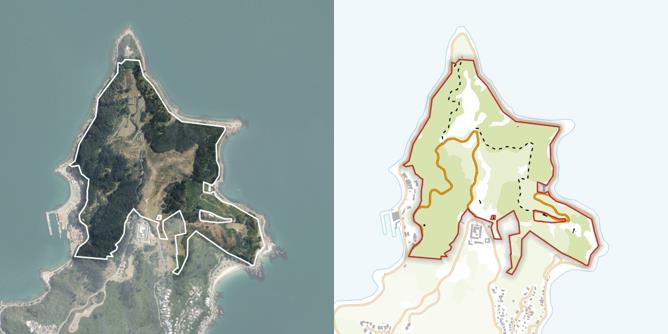
Crown Land
iwi to explore options for the future ownership, governance and management of Watts
Peninsula.
Following those discussions, advice will be prepared for you as Minister for Land
Information, the Minister of Conservation, and Minister for Māori-Crown Relations: Te
Arawhiti to decide if the current Cabinet mandate should be implemented or changed.
There is significant public interest in access to the site and an expectation that it will be
RELE
OFFIC
open to the public. All parties agree that the site should be a public space. LINZ will seek
decisions from you on next steps.
Figure 6: Aerial and topographic maps of the land at Watts Peninsula
AL S D UNDER THE
INFORMATION
3.2.3 Other Crown-owned land held by LINZ
LINZ administers land acquired from government agencies that have since been
disestablished. This includes soil and river conservation land and state coal reserves
(transferred from the Environment and Economic Development Ministries), and land
formerly held by Railways or the Electricity Corporation.
This land is held under a range of legislation such as the PWA and the New Zealand
Railways Corporation Act 1981. LINZ is responsible for its day-to-day management
3.2.3.1 Crown forest land
ACT
Historically, the Crown owned plantations of exotic trees throughout New Zealand Most
of these forests were sold between 1990 and 1992, but the land itself was retained for
transfer to iwi under Treaty of Waitangi settlements.
LINZ manages this land on behalf of the Crown under the Crown Forest Assets Act 1989
and administers the licences (Crown Forest Licenses) which the Crown has granted to
forestry companies to grow trees on the land. The rents from these licences are
transferred to the Crown Forestry Rental Trust, which holds and invests these proceeds on
behalf of future Treaty of Waitangi claimants.
15

Crown Land
with and makes decisions under delegation on applications for interests in reclaimed land,
such as leases or sale.
3.2.4 The Treaty Settlements Landbank
LINZ holds and manages a large portfolio of land for future Treaty settlements. Some land
is held in LINZ’s general Crown estate, but most is held in the Treaty Settlements
RELE
OFFIC
Landbank (Landbank). It includes forests, commercial properties, farms and residential
houses.
You have certain Landbank responsibilities which include:
• financial approp iations relating to managing and maintaining the portfolio
Other ministers also have key roles in relation to the Landbank:
AL S
• properties that are acquired and prepared for settlement are overseen by the
Minister for Treaty of Waitangi Negotiations
• properties that are acquired for settlement are decided by the Minister for Māori
D UNDER THE
INFORMATION
Development (LINZ acquires the prope ties). Your approval is required for these
acquisitions.
Land is usually added to the Landbank as part of Crown property acquisitions and
disposals processes (outlined later in this briefing) that occur when land is no longer
required by a government agency. In areas where Treaty settlements are still to be
reached, the land can be advertised through the Māori Protection Mechanism.4 If there is
interest from iwi, the Crown may purchase the land from the agency and add it to the
Landbank.
There are situations where the Commissioner is asked to acquire private land, by
agreement with the landowner, for addition to the Landbank. In these cases, LINZ will
seek your approval to purchase the land under the Land Act.
There are about 900 properties in the Landbank, of which nearly 700 have built structures
404 of which are residential houses (as at 30 June 2023).
LINZ engages with iwi claimant groups on the properties, as it is responsible for
ACT
managing and prepare properties, including responsibility for remediation and demolition
work, for transfer to these groups. As at 31 October 2023, 50 residential properties are
under refurbishment, with 33 additional projects underway ranging from demolitions, civi
works, asbestos remediation to land remediation works.
4 This mechanism is administered by Te Arawhiti – Office for Māori Crown Relations and occurs before land can be offered
for sale on the open market.
17
Crown land
LINZ is also responsible for post-settlement obligations and commitments including
ongoing relationship agreements. Te Arawhiti – Office for Māori Crown Relations provide
advice on the overall Treaty settlement work programme.
The portfolio includes a wide range of property types in varying condition. Some
properties are tenanted, and some can present property management challenges such as
hazard management.
RELE
OFFIC
LINZ took over the management of the Landbank portfolio in 2016 from the Ministry of
Justice. Since then, LINZ has been increasing its understanding of the portfolio through
asbestos surveys and detailed condition assessments.
As part of LINZ’s obligation under the Healthy Homes regulations, in 2019 LINZ
commenced a Healthy Homes programme. The work makes improvements to
approximately 700 properties in the Landbank and wider LINZ portfolio, to meet the
AL S
Healthy Homes Standards.
3.2.4.1 Regional Housing Improvement Programme
D UNDER THE
INFORMATION
Through Budget 2022, LINZ secured funding over four years for repairs and maintenance
on Landbank tenanted houses for the Regional Housing Improvement Programme.
This funding will enable LINZ to maintain Landbank housing that is tenanted and ensure
these homes are ready and fit to be transferred to iwi as part of future Treaty settlements.
The programme of work prioritises repairs based on the condition of houses and the
availability of building materials and workers. LINZ anticipates that it will be able to
improve 191 properties over a four-year period.
3.2.5 Client agency land
LINZ manages and disposes of land on behalf of other public sector agencies (client
agencies) through memoranda of understanding. Client agencies may include the
Ministry of Education, New Zealand Police, Department of Corrections and NZTA. LINZ
manages the disposal process for these properties.
LINZ is responsible for the day-to-day management of these propertie LINZ is focused
ACT
on bringing approximately 934 properties (as at 30 June 2023) up to the new Healthy
Homes Standards, ahead of the 1 July 2025 legislative compliance date.
18
Crown Land
3.3 LINZ has responsibility for biosecurity and
biodiversity on Crown land it manages
3.3.1 LINZ’s biosecurity and biodiversity programme
LINZ is tasked with managing land to ensure it is protected and used in line with New
RELE
OFFIC
Zealand’s long-term interests. This includes conducting biosecurity control work and
protecting biodiversity values.
The land LINZ manages includes South Island braided riverbeds, the Queenstown Lakes,
rivers and lakebeds in the North Island, including Te Arawa Lakes in Rotorua, Lake
Karāpiro and the Waikato River. LINZ’s programme includes both underwater (aquatic)
and terrestrial weed control and focuses on high-priority sites.
AL S
LINZ meets statutory and other biosecurity obligations as an administrator of Crown land,
including Regional Pest Management Plan requirements. LINZ’s biosecurity work is
aligned with the national biosecurity and biodiversity programmes and strategies it works
D UNDER THE
INFORMATION
within.
Management of pests and weeds requires collaboration among government
organisations, iwi and rūnanga, farming lessees, landowners and communities. LINZ works
with multiple stakeholders on coordinated control operations and engages contractors to
undertake control work.
LINZ uses mapping and geospatial expertise to identify and track pests and weeds at sites
across the country. This data is shared with partners and community programmes,
supporting community restoration and national biosecur ty control programmes such as
the National Wilding Conifer Control Programme and wallaby control, and the ‘Clean
Check Dry’ campaign aimed at reducing the spread of aquatic weeds.
3.3.1.1 Jobs for Nature
In Budget 2020 LINZ received funding for Jobs for Nature over four yea s. The 2023/24
financial year will see the end of the programme. Jobs for Nature funding allowed LINZ to
expand its biosecurity and biodiversity programme:
ACT
• increasing the number of lakes in the aquatic biosecurity programme
• targeting species that pose the greatest risk in the terrestrial biosecurity
programme
• strategic projects including trialling different pest and weed control methods
• improving information and data
• improving monitoring and reporting by collecting baseline data across sites and
species to inform environmental outcomes reporting.
As in the first two years of the programme, LINZ has met its targets for the third year.
19
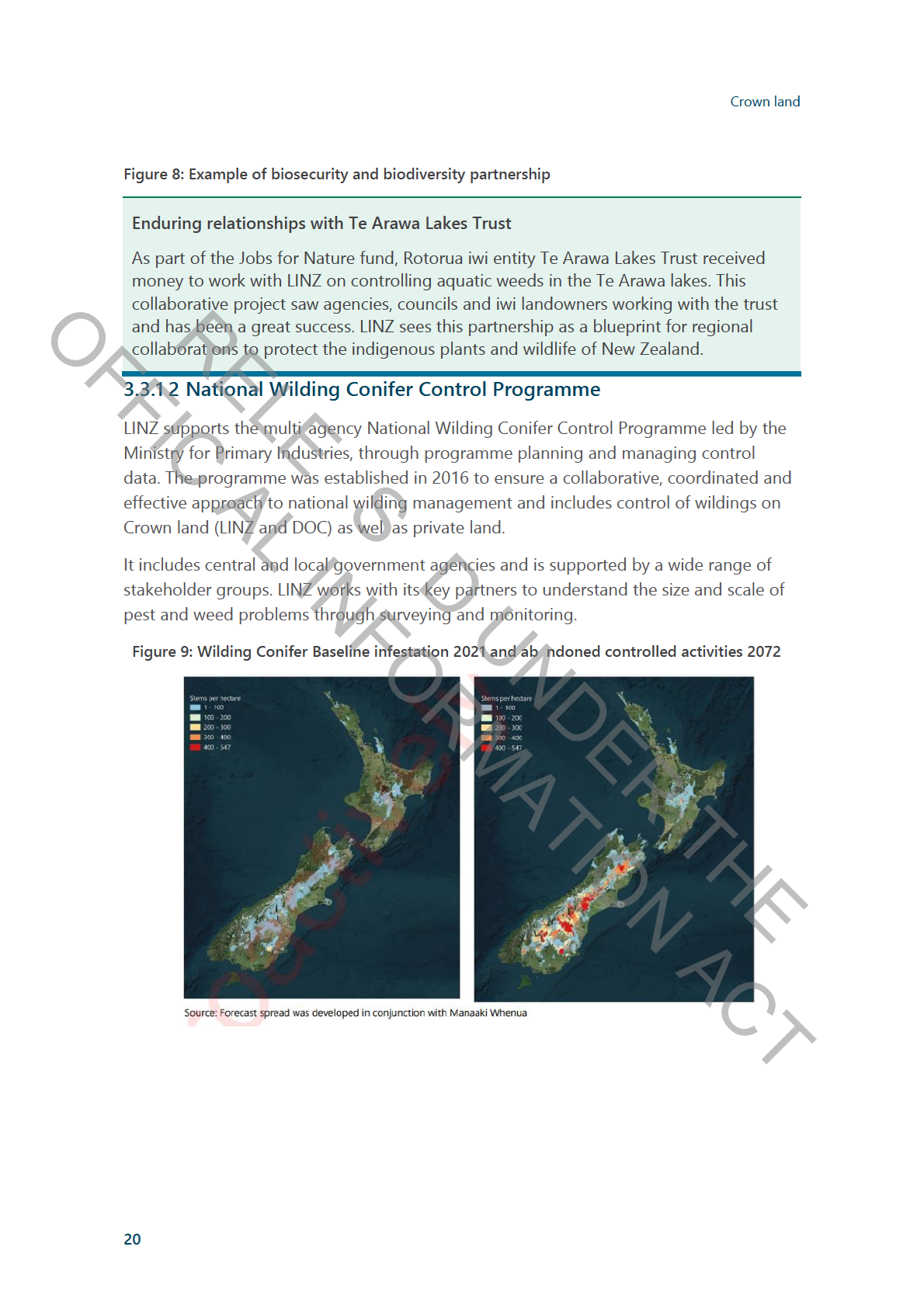

Crown land
You are responsible for two statutory functions under the PWA that cannot be delegated
to LINZ. This is because these two functions are a significant exercise of the Crown’s
powers. Figure 11 below outlines these functions:
Figure 11: Minister for Land Information PWA statutory functions that can not be delegated
Notices of intention to Signing notices regarding the Crown’s intention to take
OFFIC
take land
the land. These notices advise the landowner that the Crown
RELE
(under s23 of the PWA)
intends to take the land for a public work. The owner can
object to this notice in the Environment Court.
Taking land by
Recommending the Governor-General take land by
proclamation
proclamation. Local authorities may acquire and dispose of
(under s26 o the PWA)
land for local works without involving you except in
instances where powers of compulsory acquisition (taking
AL land by proclamation) are used. In these cases, your role
Sunder the Act is to request the proclamation from the
Governor-General, on behalf of the local authority.
D UNDER THE
INFORMATION
The rest of your PWA functions are currently delegated to LINZ. Should you wish to
review these delegations, LINZ can provide you with advice.
Annex 2 provides a summary
of functions and responsibilities under the PWA for you as Minister for Land Information,
and as delegated to LINZ.
4.1.1 Landowners have the right to object
A landowner can object to their land being taken by compulsory acquisition. Objections
are heard by the Environment Court, which can either:
• uphold (confirm) the objection, in which case the compulsory acquisition is halted
• determine that it is fair, sound and reasonably necessary for the Crown (or local
authority) to take the land for the public work.
4.1.2 Compensation must be offered for the land
If a landowner does not agree with the amount of compensation offered and no
ACT
negotiated agreement can be reached, the matter can be referred to the Land Valuation
Tribunal (the Tribunal). This is an independent tribunal that ensures compensation under
the PWA is fair and consistent. When land is taken by proclamation:
• the owner can still make a claim for compensation to the Tribunal
• parties can enter into agreements to settle compensation, without going to the
Tribunal.
22
Crown Land
Under the PWA, the owner has two years after proclamation to make a claim for
compensation to the Tribunal. All efforts are made to resolve compensation by agreement
with the landowner before the Tribunal stage.
For New Zealand Upgrade Projects for NZTA, a Land Acquisition Resolution Service (LARS)
has been set up to mediate with willing owners to reach agreement. This was a joint
initiative between NZTA and LINZ. The service has been used three times in 2023 with
RELE
OFFIC
successful out omes and is expected to be used more.
4.2 Land that is no longer needed for public works
When land is no longer needed for public works, there is a disposal process set out in
legislation and government-policy for the disposal of that land. The LINZ chief executive
is responsible for decisions on disposals. When land is identified as surplus the following
AL S
four steps apply:
1. the land is declared as surplus, and LINZ determines whether there is any other public
work requirement for the land5
D UNDER THE
INFORMATION
2. the land is offered back to the former owners or their successors, unless an exemption
applies
3. any Treaty settlement obligations are met, which could be offering the land to iwi
under a right of first refusal6, or determining if it is appropriate to include it in a Treaty
settlement under the Māori Protection Mechanism
4. any land that has not been disposed of by following the three steps above is offered
for sale on the open market.
Disposing of land can be contentious, and actions can include managing interest from
former owners and iwi, including any legal action that may arise. Histo ically, this has
been a highly litigious area with new case law being applied to mitigate risk. Media can
also take an interest in Court cases. LINZ manage any queries and will work with your
office and subject matters experts on any responses. LINZ will update you as needed on
matters of interest or concern that arise from decisions made under delegation.
Although the LINZ chief executive is the decision-maker on disposals, the Crown agency
ACT
that held the land is responsible for completing this process. The agency will use a Crown
property accredited supplier to dispose of the land, and the agency must ask LINZ for
approval before any actions are taken.
5 If so, the land may be transferred to the Crown agency (via section 52) or local authority (via section 50) that requires the
land.
6 A right of first refusal is a type of Treaty settlement redress that requires the Crown to offer a long-term option for iwi to
purchase or lease Crown-owned land. The right wil generally remain in place for 50 to 170 years.
23
Crown land
To give you a sense of scale for this work, 40 disposals of land were made by LINZ
in 2022/23.
4.3 Improvements to PWA processes
LINZ has been working with other agencies on ways to improve operational practices to
OFFIC
address some issues with PWA processes. NZTA has previously expressed concern that
RELE
the length and complexity of the PWA process may slow down high-priority projects. To
address this LINZ has made operational improvements to the acquisition process which
include actions in the following areas:
• LINZ has updated and improved the information provided to landowners affected
by acquisition under the PWA.
AL S
• LINZ worked with NZTA and Crown Law to pilot more frequent use of mediation in
valuation disputes (the LARS mediation programme).
• LINZ has finalised a pre-approval process in paying owners’ valuation and legal
D UNDER THE
INFORMATION
costs up to various thresholds to create efficiencies in the negotiation and
acquisition process.
ACT
24
Crown Land
5 Strategic outlook for Crown land
The Crown estate already creates value for New Zealanders and there is growing
awareness that it could have more value as a national asset.
It provides farming and forestry use and contributes to ecosystem restoration, climate
adaption and biodiversity protection objectives. Agriculture is the primary economic use
RELE
OFFIC
of Crown land, but other industries could be considered, such as high-value technology or
renewable energy (using advanced technologies to install wind farms or solar panels;
placing smart sensors and interactive features on the land that encourage visitor activity
and engagement) Other potential opportunities may arise in providing managed retreat
solutions and flood p otection works.
There are many connections between Māori, local and central government in this area,
AL S
with a number of key community stakeholders with valuable insights. There are
opportunities to hold discussions across government and with businesses and
communities about the future use and management of this land. LINZ will discuss further
D UNDER THE
INFORMATION
with you the ways in which Crown land could continue to grow in value and the
opportunities it will bring for New Zealand.
ACT
25
Crown land
6 Next steps
LINZ can arrange a meeting to discuss Crown land and will brief you shortly on next steps
for Public Works Act decisions.
LINZ is ready to respond to your direction on priorities for Crown land as part of your
Land Information portfolio responsibilities. LINZ can develop advice and options for
RELE
OFFIC
issues of importance to you. LINZ will also provide advice on implications for Crown land
as wider gove nment priorities are progressed.
AL S D UNDER THE
INFORMATION
ACT
26
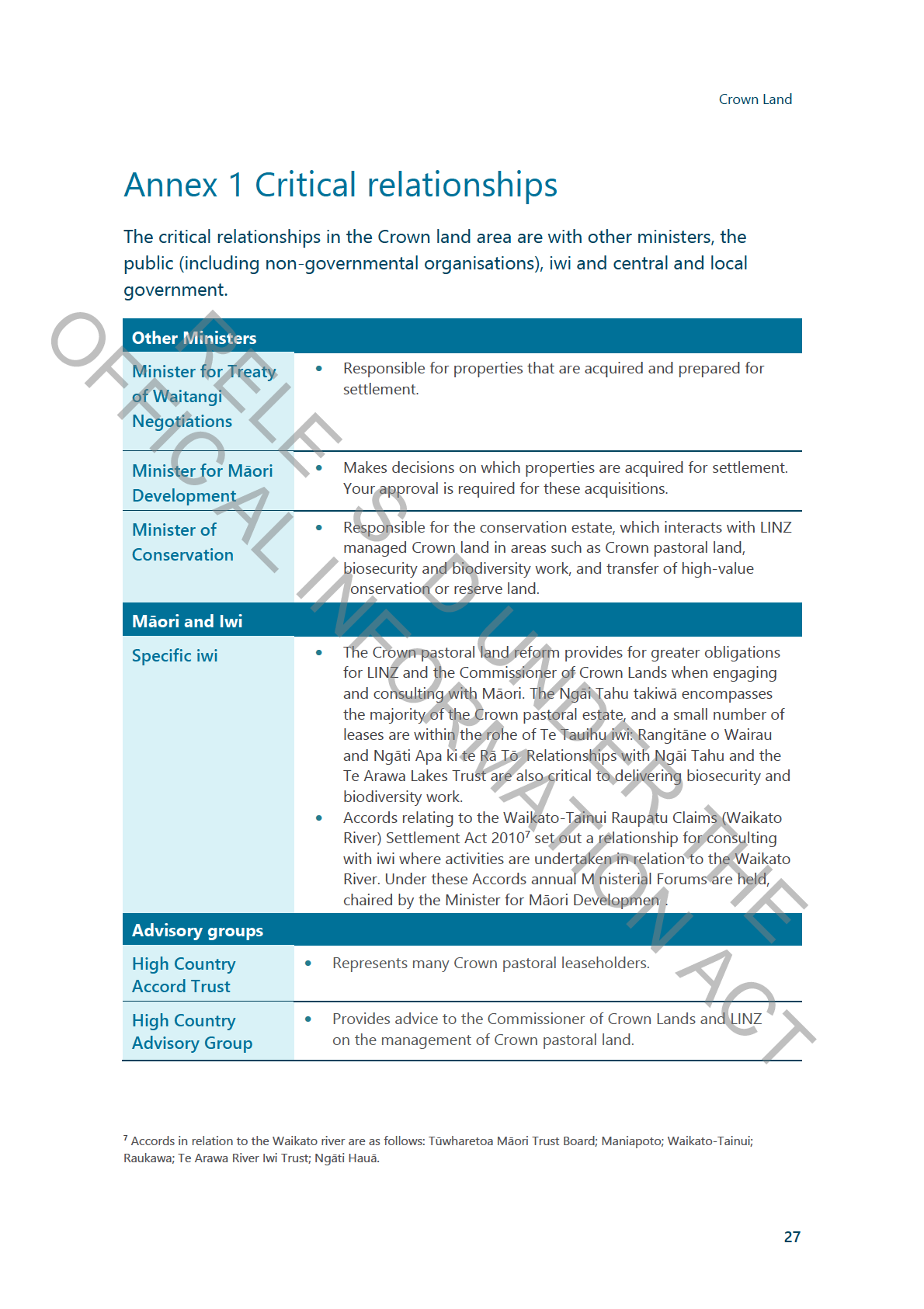
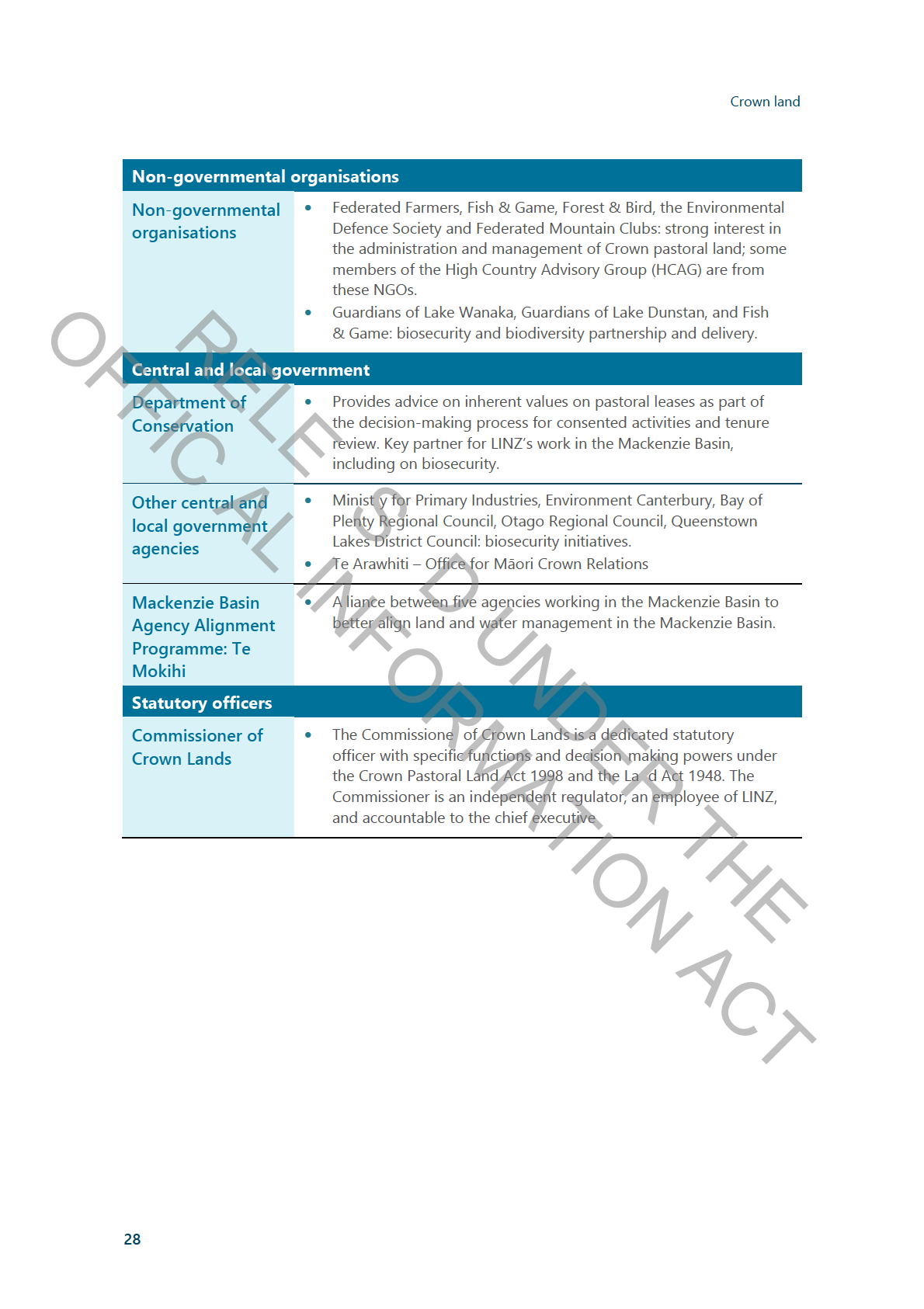
Crown Land
Annex 2 Functions and responsibilities
under the PWA
The different functions and responsibilities as set up under the PWA are:
OFFIC
Governor General
RELE • Issues proclamation for land to be compulsorily
acquired under s26 of the PWA
Minister for Land Information
• Considers notice of intention to take land under s23
of the PWA
• Recommends proclamations for government and
local works under s26 to the Governor-General
AL S
By LINZ on behalf of Minister
• Agreements to acquire land, including notices of
for Land Information (current
desire to acquire land under s18 of the PWA
delegations)
• Agreements to change the public work purpose for
D UNDER THE
INFORMATION
which and is used
LINZ
• Manages the disposal process for PWA properties
managed by LINZ or client agencies
• Manages the Crown estate regulatory system that
sets the rules and standards by which government
agencies can acquire or dispose of land under the
PWA
• Maintains the Crown property acc editation system8
• Advises stakeholder agencies on how the PWA can
or cannot be applied to meet their land
requirements
• Agreements to:
o offer back of land to former owners
o
ACT
sell PWA land or transfer to a local authority
o roading actions.
8 The Crown outsources much of the operational and reporting functions for acquisition and disposal under the PWA to the
private sector through a system of suppliers accredited by LINZ due to their knowledge of the PWA. Accredited suppliers
cannot bind the Crown, must comply with LINZ’s standards, and seek approval from the department in statutory decisions.
29













